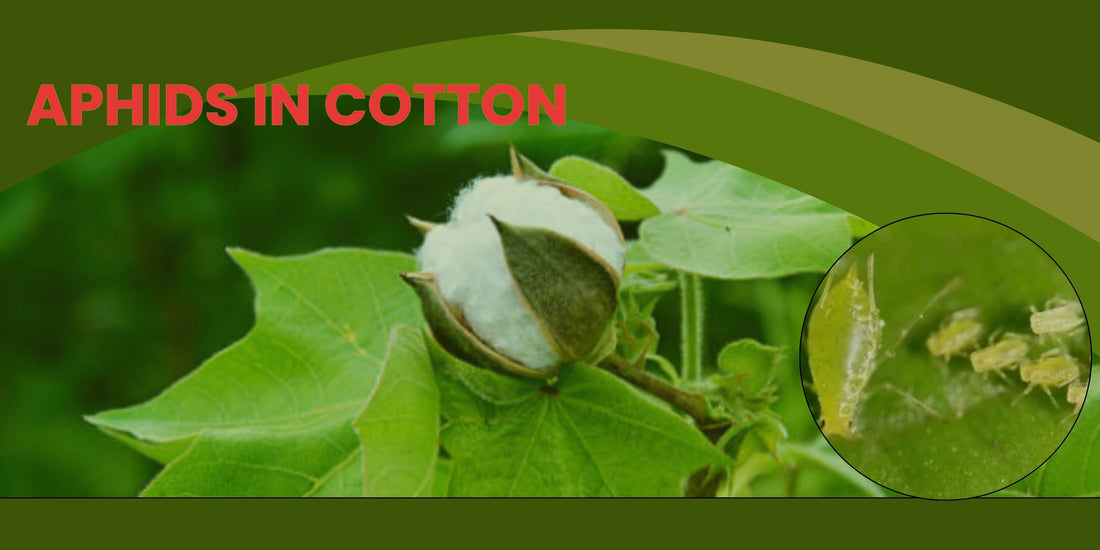
APHIDS IN COTTON
Telugu name: Penubanka
Scientific name: Aphis gossypii
Identification characters:
- Destructive stage: Nymphs and adults.
- Reproduction by parthenogenesis and viviparity.
- Nymphs: Small, yellowish or brownish in colour and mostly wingless. Nymphal period: 7-9 days.
- Adults: Yellowish brown to black with black cornicles and yellowish green abdominal tip. Adult longevity: 12-20 days.
Lifecycle:
Aphids reproduce prolifically. Those found in cotton reproduce asexually, giving birth to live young without mating.Nymphs are born with developing embryos already present-essentially, aphids are born pregnant and give birth to genetic clones of themselves. One female may produce as many as 80 young females that mature within 8 to 10 days. It is possible for aphids to have as many as 50 generations a year. Under optimum conditions, these generations can occur as often as every 5 to 7 days.In the growing season, aphids usually appear on the undersides of leaves,on stems, in terminals, and on blooms and fruit.
Symptoms:
- Infesting tender shoots and under surface of the leaves.
- Curling and crinkling of leaves
- Stunted growth
- Blighted appearance when infestation is severe
- Development of black sooty mould due to the excretion of honey dew giving the plant a dark appearance.
Favourable Conditions:
- Aphids thrive when the weather is warm but not too hot, typically between 20-30°C.
- Low rainfall or dry weather creates an ideal environment for aphids to multiply.
- Excess application of nitrogen fertilizers makes plants tender and juicy, which aphids love to feed on.
- Avoid Dense Planting,as it reduces air circulation and creates favorable environment for aphids.
- Poor water mangement, drought, or poor soil conditions are more prone to aphid infestations.
ETL: 15% of infested plant.
Management:
Cultural Practices:
- Maintain Proper Spacing between plants .
- Remove weeds around cotton fields, as they can serve as alternate host for aphids.
- Follow crop rotation by alaternating cotton crop with non-host crops like cereals.
- Use well-drained soil, and limit nitrogen application, as excessive nitrogen promotes aphid growth.
Biological Control:
- Promote Beneficial Insects like Ladybirds and lacewings that naturally feed on aphids. Avoid broad-spectrum pesticides to protect these helpful insects.
- Grow Trap crops like marigold around your field to attract aphids away from cotton.
Chemical control:
- Use insecticides only when aphid infestation is high and damage is more.
- Avoid spraying too often to prevent resistance.
- Use insecticides like
- Neem-based products (organic option).
- Imidacloprid or Thiamethoxam (systemic insecticides; apply carefully).
- For Effective control of Aphids in cotton use Biopesticide “Dr.Eliminator”@250 ml/acre.
FAQs:
1. What are the symptoms of Aphid infestation in cotton?
Curled and crinkled leaves, Brighted appearance when infestation is severe and black sooty mould formation due to honey dew secretion.
2. How does aphids affect cotton crop?
Aphids are sucking pests, they weaken the plants by sucking sap from it and thus leading to reduced yield and affects fiber quality.
3.What are some ways to prevent aphids from attacking cotton crop?
Use resistant varieties, manage weeds, and encourage natural predators like ladybugs.
4. When should I start monitoring for aphids in my cotton field?
Start early, just after planting. Regular checks help catch infestations before they spread.
5.What are some common mistakes to avoid in aphid control?
Avoid overusing chemical pesticides—they harm helpful insects and can lead to resistance. Rotate treatments for better results.
